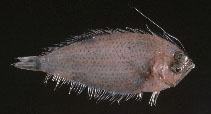| Family: |
Citharidae (Citharids) |
| Max. size: |
14 cm TL (male/unsexed) |
| Environment: |
demersal; marine; depth range 18 - 92 m |
| Distribution: |
Indo-West Pacific: Persian Gulf through the eastern Indian Ocean to the East Indies. |
| Diagnosis: |
Dorsal spines (total): 0-0; Dorsal soft rays (total): 65-77; Anal spines: 0-0; Anal soft rays: 41-50. Ground color yellowish or yellowish brown; dorsal, anal and caudal fins paler than body with dark spots. Blind side whitish. Some anterior dorsal fin rays elongated in males, not in females, all rays except a few at posterior end of fin unbranched. Pectoral fin on eyed side with 11-13 rays, on blind side with 10-13 rays. Caudal fin with 13-14 branched rays and rounded margin. |
| Biology: |
Inhabits sand and mud bottoms (Ref. 9797). Frequently collected in areas near river mouths (Ref. 9797). Feeds on bottom-living animals (Ref. 9797). Mostly used in making fish meal but is also marketed fresh (Ref. 9797). |
| IUCN Red List Status: |
Least Concern (LC); Date assessed: 17 December 2020 Ref. (130435)
|
| Threat to humans: |
harmless |
Source and more info: www.fishbase.org. For personal, classroom, and other internal use only. Not for publication.

